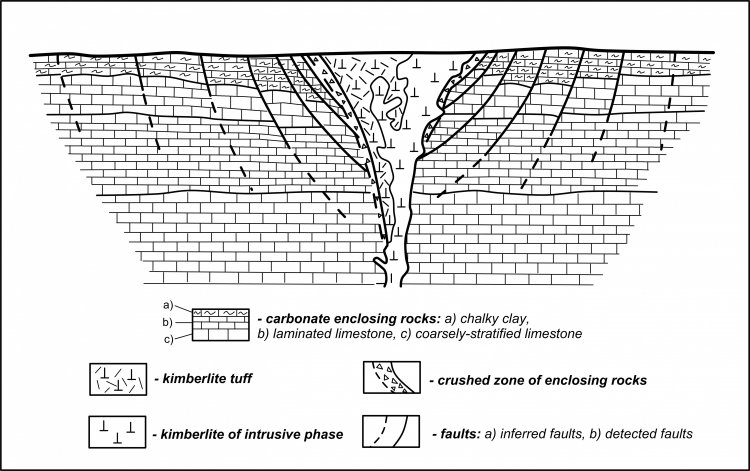Arkhangelsk scientists are developing an emanation method based on the use of radon gas that can indicate the presence of kimberlite bodies in the diamond-rich regions of the country
The structure of the diamond-rich province, on the territory of which kimberlite pipes (vertical tube-shaped bodies formed as a result of magma penetration) are localized, predetermined the need for using the most effective search methods and conducting a thorough detailed mineralogical study. However, the geological-tectonic, paleogeographic, and morphological situation, presence of sedimentary and igneous formations determine the difficulties of detecting and predicting kimberlite bodies and related rocks within which the diamond deposit is located. Traditional geophysical and geochemical methods are not always effective, so there was a need to develop new technologies and exploration methods for detecting kimberlite pipes at diamond deposits; in particular, in Arkhangelsk Oblast.
Scientists of the N. Laverov Federal Center for Integrated Arctic Research of the Ural Branch of the Russian Academy of Sciences (FECIAR UrB RAS , Arkhangelsk) are conducting fundamental research to identify the criteria that may indicate the presence of kimberlite bodies or ore-controlling structures in diamond-bearing areas. Specialists determined the specifics of the radon gas field around the explosion tubes and found an increased background level of radon in the soil air, as a result of which an original mechanism for the formation of increased radon over kimberlite bodies was proposed. The scientists have carried out a number of experimental works assessing the emanating ability of different rock types, which confirm this mechanism.
Evgeny Yurievich Yakovlev, Candidate of Geological and Mineralogical Sciences, Head of the Laboratory of Environmental Radiology at the Institute of Geodynamics and Geology of the FECIAR UrB RAS (Arkhangelsk), told us what kimberlite pipes are and what reliable method has been proposed by scientists for their detection based on the use of radon.
“Diamonds are a strategic raw material, their role in the economy is enormous: industry, quantum computers, microelectronics, semiconductor technology – diamonds are needed everywhere. And, of course, jewelry production. Russia ranks first in the world in diamond reserves and production. Industrial diamond reserves are known only in three regions of Russia: the Republic of Sakha (Yakutia), Arkhangelsk Oblast, and Perm Krai. In the first two regions, there are indigenous deposits (pipes), and in Perm Krai – placer deposits. However, in recent years, there has been a decline in diamond reserves in Russia. There are estimates that over the next 20 years, the explored diamond reserves will be fully worked out. This situation can be changed only through the reproduction of reserves, that is, through the discovery of new deposits. However, in recent years, no deposits of any significance in terms of diamond reserves have been discovered, although scientists, subsurface users, and design organizations are making significant efforts to avoid a possible raw material crisis. The only way out is to improve approaches to forecasting and searching for diamond deposits. Many of the known kimberlite pipes were discovered by standard geophysical methods: in particular, by magnetic exploration, since due to the magnetic minerals contained in the pipes, they were distinguished by magnetic field anomalies. However, this method effectiveness began to exhaust itself, especially in difficult geological conditions, in the areas with a large thickness of overlapping deposits: the percentage of pipes found in the identified anomalies gradually decreased. In addition, a number of tubes in geophysical fields are poorly manifested, that is, their contrast is weak or nonexistent. These are the most difficult tubes to find, but in some cases, such tubes are highly diamond-bearing. Direct methods of searching for pipes also exhaust themselves. These are the so-called schlich mineralogical methods, when indicator minerals are searched for in loose sediments, for example, bottom sediments of rivers, which, together with diamonds, are in tubes and due to erosion fall into loose sediments.
But if we talk about Arkhangelsk Oblast, our pipes contain relatively few indicator minerals, especially pyropes. As a result of secondary geochemical transformations of kimberlites (saponitization), light minerals occupy most of the total volume of the tubes. In addition, most of the pipes are poorly eroded and have a crater part, which makes it difficult for indicator minerals to enter the environment. In connection with these circumstances, the issue of improving existing methods and developing more effective methods of diamond prospecting becomes urgent. Such work is carried out by both scientific organizations and companies-subsurface users. We believe that a possible direction in the development of new methods for searching for kimberlites may be the development of an emanation method based on the use of radon, and here’s why. It is known that radon – an inert radioactive gas – is an indicator of some geological phenomena and it is widely used in geophysics and geology. According to its volume activity, for example, geodynamic activity, seismic events are analyzed, geological mapping, fault tracing, etc. are performed,” Evgeny Yakovlev rationalized in detail the need to develop new models for tracking geological processes and searching for diamond-containing kimberlite pipes based on the manifestations of radioactive radon gas.
Why did kimberlite pipes become the object of your search and what are they?
“Diamonds in Arkhangelsk Oblast are mainly found in kimberlite pipes. This is a geological formation, a deep diamond-containing magma of a special composition, frozen in the bowels of the earth and having a tubular shape. The tube top is crowned with a bell crater since this is a kind of mini volcano. And its thin elongated mouth goes deep down. The rise of magma was rapid, explosive, so they are called explosion tubes. Kimberlite pipes were formed in Arkhangelsk Oblast about 370 million years ago: in geological chronology, this is the late Devonian.
Kimberlite magma penetrated along the weakened zones of the Earth’s crust, along faults. In one fault, magma could be embedded in several places, forming several tubes at once, stretched in a chain along the fault. At the time of ascent through the host rocks, kimberlite magma exerted a strong mechanical impact on the host medium due to pressure, temperature, gases, melts (the area of contact between kimberlite magma and host rocks is called the near-tube space). It resulted in the formation of systems of radial and concentric cracks in the near-tube space of the tubes with crushing and vertical displacement of the host rock blocks. In turn, the development of fault zones and increased fracturing creates conditions for radon transport in the host rock massif since the amount of radon gas activity is one of the signs of the geological environment permeability. This is the initial prerequisite for the use of emanation methods for kimberlite pipe searching,” explained the scientist.
Diagram of a kimberlite pipe near-tube structure
How do you register the presence/release of radioactive radon indicating the presence of kimberlite pipes in diamond-bearing areas?
“Radon radioactive gas does not directly tell us about the location of kimberlite pipes, it only indicates the territory structure features that may be associated with ore-controlling structures or pipes.
To determine the nature of the radon field that would indicate the presence of permeable zones – faults, fractures, we study the distribution of the radon volume activity in soil sediments. To do this, a hole is drilled in the ground with a diameter of 2–3 cm and to a depth of 0.7–1.0 meters. The hole is small; actually, it’s a prick, so it does not harm the soil and vegetation cover. A thin soil air sampler is lowered there and kept for at least 12 hours to fill with radon. After removing the sampler, the radon accumulated in it is pumped into the measuring chamber of the radiometer, which gives us the value of the radon volume activity. The measurement itself is done quickly, but the process of radon accumulation in the sampler is long (at least 12 hours). To speed up the work, we use several samplers at the same time, in which, after extraction from the soil, radon can be measured sequentially. There is a way to measure the work quicker – to measure the radon flux density from the earth’s surface. In this case, the sampler is something like a plate with a known area, which is placed upside down on the ground, and radon is measured almost immediately. But this “fast” method has its drawbacks. Since radon is measured from the earth’s surface, the output of radon is strongly influenced by the atmosphere parameters, pressure, humidity, time of day. Therefore, radon variations can be significant. In this regard, we measure radon in the soil air, this is a more reliable method,” the Arkhangelsk researcher said.
The specialists of the Institute of Geodynamics and Geology have been conducting long-term fieldwork at the Lomonosov diamond deposit, as well as in the areas of other explosion tubes located in Arkhangelsk Oblast under the guidance of Honorary Subsurface Prospector, Doctor of Geological and Mineralogical Sciences Georgy Petrovich Kiselev. According to Yevgeny Yakovlev, his teacher and scientific supervisor, an outstanding geophysicist Georgy Kiselev, “worked for a long time in Kyrgyzstan in Central Asia, used radioactivity methods to search for mineral deposits. Here, in the North, he decided to apply his experience and knowledge to the development of radiometric methods for minerals prospecting, in particular, for diamonds, since the prerequisites for this existed.”
The researchers studied the volume activity of radon in the area of the well-known pipes of Arkhangelsk Oblast, because, according to Yevgeny Yakovlev, “this is a good test site. As a result, many interesting features of radon field in the soil air above the tubes were revealed. It was found that in the soil horizons above the kimberlite bodies, there is an increased radon volume activity that exceeds the background indicators by several times. At the same time, the most contrasting radon anomalies are formed in the near-tube space of kimberlite bodies, a certain subring character of the radon field is observed, which probably reflects the development of fracturing and fault zones at the tube contact with the host deposits, which creates conditions for radon transport in the rock mass. In addition to the increased rock permeability in the near-tube space, the concentration of the parent nuclides for radon – uranium, radium – has a significant impact on the observed radon activity. In the course of studying the host rocks in the tube quarries, it was demonstrated that the host rocks in contact with the tube have an increased background level of natural radionuclides, while the kimberlites themselves practically do not contain any radioactive elements. In general, the radionuclides activity in the host rocks is low, but sufficient to produce additional radon.”
Geological section of the Lomonosov deposit kimberlite pipe (adapted from Ignatov P. A. et al., 2012), 1 -Quaternary Glaciofuval deposits; 2 - Middle Carboniferous deposits; 3 - Upper Vendian deposits; 4 - tuff-sedimentary rocks of crater facies; 5 - kimberlites of vent facies
At the time of their formation, kimberlites made a huge impact on the host rocks. Evgeny Yakovlev explained in detail what geological changes take place: “As a result of the mechanical action of kimberlite magma, pressure, temperature, gases, water, a whole series of pronounced changes – tectonic, mineralogical, geochemical – has formed in the rocks surrounding the tube. In particular, the proper conditions were created for the accumulation of a small amount of natural radioactive elements in the host rocks. A probable mechanism of forming increased radon activity, which we see above the tubes, is as follows: radon produced by the rocks of the near-tube space and due to the increased host rock permeability enters the surface, where we register it in the soil air. But this is a theoretical explanation of the observed phenomenon. It was important for us to quantify which types of rocks compose the kimberlite field (kimberlites containing and overlapping sediment tubes), how much radon they produce, and what their physical parameters are. And we have conducted such studies. This research was carried out within the framework of the Stability youth grant of the Russian Foundation for Basic Research No.20-35-70060. To do this, we conducted experimental work directly with rock samples. We have studied a whole range of radiation and physical properties of different types of rocks composing the kimberlite field. In the experiment, we determined the activity of radium-226 (the parent nuclide for radon), the activity of radon in the free state, the coefficient of emanation, the level of radon production, porosity, density for various types of rocks represented by kimberlites of the tube mouth, tuff-sedimentary rocks of the crater, enclosing and overlapping deposits. These parameters were chosen as the most indicative in the study of the mechanism of radon field formation in soil sediments over kimberlite pipes.”
In addition, during the year, specialists conducted experiments with dozens of selected samples, each of which took 3–4 weeks to study, since it was necessary to seal each counting sample to achieve a radioactive equilibrium of radium-226 with daughter decay products. As Yevgeny Yakovlev notes, “it was shown that among the studied rock types, the largest amount of radon in the free gas state is produced by rocks of the near-tube space, represented by Vendian deposits and characterized by the high values of emanation coefficient, specific radium activity, the rate of radon production and porosity. This is due to the structural and geological features of the near-tube space having the signs of kimberlite magma impact on the host rocks.
The obtained experimental data allowed the scientists of the FECIAR UrB RAS to construct a numerical model that describes the distribution of radon in different types of rocks based on the results of calculating the rate of radon production and confirm the information obtained during fieldwork. The work results are published in the international peer-reviewed Applied Sciences journal, which is part of the Web of Science database (quartile Q2) https://www.mdpi.com/2076-3417/11/13/6065.
“This study expands the knowledge about some new opportunities for the development of emanation methods for searching for kimberlite pipes in Arkhangelsk Oblast,” Yevgeny Yakovlev emphasized.
How do you assess the potential prospects of your method for searching for diamond-containing kimberlite pipes for the manifestation of radon?
“So far, this is fundamental research, but in the future, it will be possible to use its results in practice. But to be able to use it in practice, there is still a very large amount of work to be done,” Yevgeny Yakovlev is convinced.
The alternative approach presented by Russian scientists has promising search signs of diamond prospecting and, probably, can prove itself in geological exploration work.
*All images are provided by Yevgeny Yakovlev
Photo Diamond
Photo Kimberlite diamond pipe























